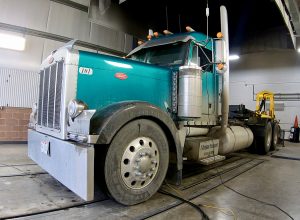Vibrations can be the death of your truck and wear out your body two hours faster per day. Torsional dampers are often referred to as harmonic balancers, but that is not the correct term – it’s a torsional damper. This damper is a critical part of the engine and helps eliminate many parts from being broken due to vibrations. Parts such as crankshafts, camshafts, accessory drive shafts, alternator brackets, air conditioning compressor brackets, the springs in the clutch disc, the flywheel bolts that hold the flywheel to the crankshaft, and the bolts that hold the flywheel housing to the block, will all last longer with a properly working torsional damper in place.
A worn out torsional damper will vibrate the shifter, the door locks, and even the steering wheel. These vibrations can make your hands numb and eventually travel up through the seat, into your body, and make you tired. A new torsional damper will give you two more hours of energy per day while driving.
Torsional dampers wear out at 500,000 miles or less and should be replaced accordingly. The torsional damper has a large steel ring inside the case, that rides on Teflon pads, and is cushioned by a very thick silicone that is under 30 psi of pressure. As the Teflon wears out, it impregnates the silicone, and a chemical reaction makes the silicone harden, causing the large steel ring inside to no longer move freely. That ring, at 1400 RPM, rotates 700 times per mile to remove the shock when the injector fires and slams the piston down!
Several years ago, we invented a mercury filled engine balancer to compensate for pistons, connecting rods, and crankshafts slightly out of balance. We recommend this balancer be mounted to the crankshaft, along with the torsional damper. The mercury filled balancer is a one-time purchase, as it does not wear out. If you want the smoothest ride, we highly recommend these balancers.
Driveshafts are another wear item on the truck that should be rebuilt between 500,000 and 800,000 miles. Driveshafts do bend and go out of balance, the carrier bearing wears out, and the universal and slip joints wear out. A good driveshaft shop can straighten, balance, and replace the worn components. This is another item that will cause unwanted vibrations in your truck.
Using a vibration analysis tool, we can determine the vibration’s origin based on its frequency. In a previous article, we introduced this topic, and in this article, we will dive deeper into engine-related vibrations. When you have a vibration that is the same speed as the crankshaft, this is known as a first-order vibration. This can include the damper, crankshaft, or clutch assembly. These vibrations can be felt with the truck sitting still and are repeatable at the same RPM.
Since the camshaft turns at half the speed of the crankshaft, vibrations will show up on the analyzer as half-order vibrations, or half the frequency of the engine speed. Within these frequency ranges, it is easy to tell if you have a faulty injector or cylinder. This can also be quickly done with a cutout test – the vibration analyzer tool is overkill. High torque vibrations are seen within the four to four-and-a-half-order vibrations. These higher order vibrations are found with the use of our dynamometer, which is the safest and easiest way to find them.
I could give more examples of orders of vibrations and their sources, but it is best to sum up this idea with the idea that everything has its own frequency, based on its rotating speed. These speeds can be calculated based on what they are attached to or the size of the rotating object. The best example of this is tires. Smaller tires spin faster or have a higher frequency than larger tires. Think about the wheels on a skateboard. These smaller wheels have to turn quicker to travel the same speed as a larger car or truck tire.
As a side note, one quick tip to calculate your tire revolutions per mile is to place a straight 2×4 on top of both drive tires and measure the distance from the bottom of the 2×4 to the ground. Then, on a calculator, divide 20168 by the measured height (in decimals) of the drive tires. This will give you your revs per mile. If someone is setting up your ECM, they will ask you for this number.
Another thing this number is used for is calculating your truck’s rear axle ratio. You can figure that out with this method. First, put your truck in direct drive and write down the speed and engine rpm. Then, take the engine rpm and multiply it by 60. Write that number down. Multiply the vehicle speed in mph by the revs per mile of the tire. Write that number down. Finally, divide the first number by the second, and you will have the axle ratio. For example, if you have a truck that does 50 mph at 1500 rpm in 11th gear (direct drive) on a 13-speed transmission, here is how you would do the math. First, you take 1500 x 60 and you get 90,000. In this example, the tire revs per mile is 507. Take 507 x 50 mph and you get 25,350. Finally, divide the 90,000 by 25,350 and you get the axle ratio, which in this case is 3.55.
Who knew there was so much math in trucking! But this stuff is good to know. Thanks again to Leroy Pershing for helping me with all the technical numbers and such. If you have questions about finding and eliminating vibrations or anything else, call us at (724) 360-4080, send us an email to information@pittsburghpower.com, or visit our shop in Saxonburg, PA – we are to help you!

